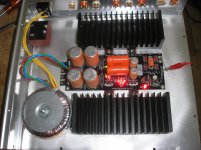The CCS works by applying a CONSTANT Voltage to the Resistor.
That results in a CONSTANT Current through the resistor.
Remove the resistor and you remove the CONSTANT from the circuit !
 D'oh!
D'oh!Initial conditions, each triplet dropped 5.7 volts. Vgs was 4.56 and 3.95. But, as I moved Vgs I got unexpected results. Dropping 4.56 to 4.36 also dropped the current through the CCS.
I found dropping Vgs of 3.95 to 3.91 did drop the current in that polarity. Both ccs resistors measure 2.9 ohms.
Is there any other way to get the ccs to match? Perhaps the 100 ohm resistor on the K170 can be adjusted? May a pot at that point?
I found dropping Vgs of 3.95 to 3.91 did drop the current in that polarity. Both ccs resistors measure 2.9 ohms.
Is there any other way to get the ccs to match? Perhaps the 100 ohm resistor on the K170 can be adjusted? May a pot at that point?
There is their Id/Vgs curve that plays also, you got to factor in everything. Look in their datasheets. Other resistors than the CCS set resistors, the LEDs, and the MOSFETs themselves don't come into it apart from big enough differences in their die temperature.
Thanks for the quick reply. This is a lot trickier than I thought it would be. The work will have to wait until at least Monday, when I am near a real computer.
Thanks for the quick reply. This is a lot trickier than I thought it would be. The work will have to wait until at least Monday, when I am near a real computer.
When you are in ballpark their tanscoductance does not differ without gross Id differences. To bring them absolutely in line is more of an aesthetic thing.
OK, I may start final wiring today, but unfortunately I still haven't gotten any advice on wiring the secondary transformer leads to the preamp board. It seems to be that one secondary coil should have a lead in the center and a lead on one of the outside taps, and the other one should have a lead in the center and a lead on the other outside tap. Does that sound right? Thanks!
An externally hosted image should be here but it was not working when we last tested it.
An externally hosted image should be here but it was not working when we last tested it.
I have some variation in the raw dc supply. About a volt. Could fixing this help? I could try to adjust the CRC to match. But is the difference due to the different loading per polarity?
It changes the drop across the CCS MOSFET so it could help, but little for just 1V difference.
I'm seeing about 10.04 VDC (positive and negative) on each rail and everything was good on my first test, no hum, good sound, but then one channel went out.
I'll need to do some troubleshooting here, but just let me confirm first:
(1) On the three "input" connections, the center goes to the ground connection on each channel of my (Goldpoint) attenuator (which is being fed from my input jacks)?
And (2) on the three "output" connections, the center goes to the ground connection on each of my output RCA jacks?
Thanks!
I'll need to do some troubleshooting here, but just let me confirm first:
(1) On the three "input" connections, the center goes to the ground connection on each channel of my (Goldpoint) attenuator (which is being fed from my input jacks)?
And (2) on the three "output" connections, the center goes to the ground connection on each of my output RCA jacks?
Thanks!
An externally hosted image should be here but it was not working when we last tested it.
Attachments
Thanks, on all counts. Any suggestions on where to start troubleshooting, when one channel just goes out suddenly but I still have power on both sides?
Rare to hear such an error report, not inherent, not a known issue. I would suspect:
-Signal path connections/solder joints/wiring.
-Relay. Tap it with the back of a screwdriver in case it latched.
-Rare to expect a weak JFET in the audio section quad that went out, but touch each of them after system warm up to make sure you got no cold one. Or compare votlages across each.
P.S. The 2K2 is the LED feed/protection resistor of course. That value has been chosen by me on the the prototypes for some subjectively pleasing luminosity. Not same LED not same panel not same distance not same room lights for everyone. You are free to dim yours further with higher value if necessary.
-Signal path connections/solder joints/wiring.
-Relay. Tap it with the back of a screwdriver in case it latched.
-Rare to expect a weak JFET in the audio section quad that went out, but touch each of them after system warm up to make sure you got no cold one. Or compare votlages across each.
P.S. The 2K2 is the LED feed/protection resistor of course. That value has been chosen by me on the the prototypes for some subjectively pleasing luminosity. Not same LED not same panel not same distance not same room lights for everyone. You are free to dim yours further with higher value if necessary.
Awesome; thanks! I'll try your suggestions.
If I want my LED a little brighter, what value do you recommend?
If I want my LED a little brighter, what value do you recommend?
1.5K. Solder or rework quick and clean in general especially around JFETs and relays, don't heat them up too much. If you got gen and scope, feed 1kHz 1V sine and follow it along the signal path with the scope's probe to see where it stops. There should be the culprit.
- Home
- Source & Line
- Analog Line Level
- Salas hotrodded blue DCB1 build

